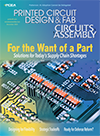Features Articles

How AI and lab-on-a-chip pave the way for economical solutions.
We could be moving into the end game with the Covid-19 pandemic, at least as far as the severest effects are concerned. Clearly, the virus and its mutations are here to stay, and the future will be about protecting us through immunization and developing better treatments. The fact that effective vaccinations have become available only a year after the pandemic was recognized is remarkable. It’s partly due to the speed with which researchers have been able to do the data crunching needed to model and understand how best to attack the virus.
In the past, the computations involved in sequencing the virus DNA would have taken vast quantities of computer time and prolonged development of the vaccine. Cloud computing using AI accelerators has dramatically shortened the time to complete the technical work involved in creating the vaccines now being rolled out.
It would be great if we could harness our technologies to create an early warning system when clusters of unusual diseases or events occur anywhere in the world. That’s exactly what organizations like BlueDot are doing right now. Indeed, BlueDot says it spotted the cluster of unusual pneumonia cases in Wuhan in December 2019 that we now know was the coronavirus. To monitor the spread of infectious diseases around the world, it analyzes a huge number of variables, not only official public health data but also climate information, international travel patterns, animal and insect population data, and others. This relies on the ability of AI to detect patterns, and exceptions to those patterns, hidden within the enormous body of information. By sifting through the reports and data points collected every few minutes, 24 hours a day, from sources around the world, using techniques like machine learning and natural language processing, BlueDot brings a small number of cases to the attention of experts for further investigation. Only with AI do we have a hope of finding those cases.
To continue reading, please log in or register using the link in the upper right corner of the page.

“We have used this vendor for years” is not a viable strategy.
As the price of PCB materials continues to skyrocket, why are some circuit board buyers stuck firmly in the past, doing business as they always have? Why, even when paying more than they should, do they fear upsetting the apple cart?
Bare board buying can be competitive, but only if those overseeing their company’s PCB supply chain are willing to occasionally buck a system put in place years ago. For circuit board buyers and procurement managers in particular, I see three ingrained habits that do damage to a firm’s PCB purchasing program and its ability to get competitive pricing.
1. Buyers are untrained. One outdated practice in the PCB industry that always amazes me is the willingness to throw buyers into the deep end without giving them 21st century training on how to buy boards. Does management assume PCB buyers will gain all the knowledge they need on the job? Sometimes, they probably do. But often, they end up costing their companies a lot of money as they learn from their mistakes.
To continue reading, please log in or register using the link in the upper right corner of the page.

How much of your budget goes to protect you from the companies that are supposed to be protecting you?
Over the past several years I have heard, learned, discussed and agonized over cybersecurity more than I would have ever imagined in my wildest dreams a decade ago. And I have invested a massive amount of money in cyber and all other types of security during this time to be safe (hopefully). When I moan and groan about the staggering cost, cultural change to our operating environment, and considerable training all employees must undergo to relearn basic computer tasks, the response I hear – usually from vendors or some other third-party – is “that’s the cost of being in business these days.”
Yes, being in business has underlying fixed costs that may change but never decline. These days some of those costs are to harden IT infrastructure and put in place systems, equipment and procedures to primarily safeguard data, and sometimes maybe even employees. Several years ago, attempting to explain as simply as possible to employees the need to prepare for cyber attacks, I drew a comparison to the pirate attacks of lore. At the time, piracy was commonplace on the coast of Somalia. Some hacker, I suggested, from a nation/state was ready to kidnap a Captain Phillips, take his ship and plunder its cargo. Indeed, I know of companies held ransom for Bitcoin losing control and access to all their IT infrastructure and basically being unable to operate systems or even shopfloor equipment.
To continue reading, please log in or register using the link in the upper right corner of the page.

Consumer pressure on corporate behavior is cyclical and typically short-lived. Consider “dieselgate.” Volkswagen for years rigged the emissions testing on certain vehicles to appear to meet state and national standards. Confronted with the discrepancies, VW management lied in what would be a futile attempt to cover up its wrongdoings. The transgressions cost the carmaker more than $30 billion in fines and penalties. At the time, it looked like a major hit to the company’s reputation.
We are in an era where focused consumer pressure has the potential for immediate worldwide impact. Primed by social media, buyers have never held so much broad sway. Will this this newfound power to drive electronics industry decision-making?
The nongovernmental organization China Labor Watch routinely pummels Chinese-based manufacturers for mistreatment of workers and labor law violations. The leading media companies in the world pick up its investigations. Yet its efficacy in changing corporate behavior is murky.
To continue reading, please log in or register using the link in the upper right corner of the page.

Getting machines to talk to each other enhances output and yields.
It’s common sense, really, and probably one of the most familiar sayings of mankind: Communication is key. Good communication is central to productive relationships, effective business strategy … just about everything, honestly. It’s not just communication, however, but communication quality and transparency that result in informed decision-making. This is especially true in the manufacturing setting and is the basis for Industry 4.0. Machines have been cranking out data for decades, but applying them in a meaningful way is, at the core, what Industry 4.0 is all about. Until recently, however, data exchange was largely supplier-specific; proprietary equipment system software could manage tasks rather seamlessly, but communication among disparate equipment brands in relation to PCB movement and traceability was challenging. The IPC-SMEMA-9851 standard provides a solid foundation and is still successfully employed, yet enhancements are required to progress toward a nimbler, automation-friendly solution that permits open and uniform machine-to-machine communication.
How it started. While several stencil printer platforms and everything within their respective ecosystems – board handling equipment, SPI and closed-loop feedback tools – are data rich, self-correcting and optimized for the printing operation, the data generated by printers relating to the PCB characteristics must be passed down the line. That, of course, means the data must be vendor-neutral. Moving beyond simple board recognition from one system to the next, true traceability is required for smart factory effectiveness. Consequently, the Hermes Standard Initiative (IPC-HERMES-9852) was born as the result of more than a dozen equipment vendors unifying behind the cause for an improved open communication protocol, which speaks volumes for the requirement and the customer desire for such a solution. By simplifying the transfer of PCB data between machines regardless of supplier, efficiency and productivity improvement are a given. And, with scalability options, board data can be customized so that when the PCB is passed from, say, the printer to the placement machine, each machine is compelled to recognize the data set, potentially add to it, and transfer that record through the assembly line, making for a more holistic view of the PCB. In fact, these data represent the digital twin of the physical PCB, and Hermes transports the PCB and its digital twin consistently down the SMT line. Integrating Hermes with IPC’s Connected Factory Exchange (CFX) standard broadens this line efficiency and communication transparency to the factory, while other MES systems can extend that to the global enterprise.
To continue reading, please log in or register using the link in the upper right corner of the page.

Gold boards are susceptible to the defect.
This month we look at solder spotting, which is often seen after first- or double-sided reflow, most commonly on gold boards. The two examples below illustrate what happens. FIGURE 1a shows two spots on a nickel/gold pad, and FIGURE 1b shows one spot on a copper OSP pad finish.
To continue reading, please log in or register using the link in the upper right corner of the page.


